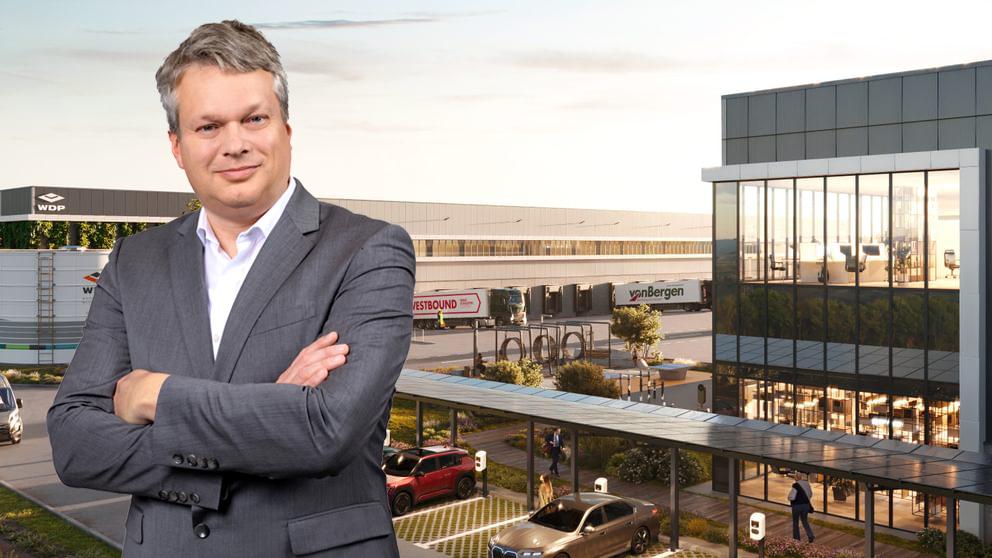WDP Strengthens Romanian Portfolio as Strategic Hub for Central and Eastern Europe
With nearly 2 million square metres of logistics space in Romania, WDP has positioned its local operations as a cornerstone of its Central and Eastern European strategy. In an interview with CIJ EUROPE, Business Development Manager Gijs Klomp explained how Romania fits into WDP’s expansion plans, the role of nearshoring, and how sustainability is shaping tenant requirements – while new projects highlight the scale of the company’s ambitions.
At the start of 2026, WDP will launch construction of a 54,000 sqm distribution center at WDP Park Bucharest – Ștefănești, developed for international non-food discounter Action. The project, located on a 15-hectare site with future expansion potential, represents an investment of around €40 million and will be delivered by the end of 2026. The long-term lease, reportedly running for at least 15 years, underscores both Action’s confidence in the Romanian market and WDP’s ability to secure large-scale, sustainable pre-let projects.
“This is exactly the kind of deal that shows why Romania remains such a priority for us,” Klomp noted. “It combines a top-tier international tenant with a sustainable, tailor-made facility. It strengthens both our portfolio and Romania’s role as a regional logistics hub.”
Beyond Bucharest, WDP is also highlighting the strategic importance of the Constanța region, where WDP Park Constanța – Lazu offers direct rail access and possibilities for a multimodal terminal connecting to the Black Sea port. The platform, marketed as offering “almost endless logistics possibilities,” is seen as a gateway for occupiers dependent on import/export flows, especially those serving Southeastern Europe. “Constanța is unique,” Klomp explained. “It’s not only about serving Romania but also about being plugged into international supply chains via the port. That’s why the site has such potential.”
Romania has become WDP’s third-largest portfolio after the Netherlands, followed by Belgium, with strong growth in France and Germany. Klomp acknowledged that WDP has considered expansion into other Central European countries, but remains focused on Romania. “Unlike other CEE countries, Romania offers the ideal combination of scale, strategic location, and growth potential that makes it an attractive focus market for us. Over the long term, we see Romania not just as a national market, but increasingly as a logistics hub that connects Western Europe with Southeastern Europe. Strengthening our presence here is therefore a key part of WDP’s broader European growth strategy.” he said.
On the demand side, Klomp pointed to the reconfiguration of supply chains in the wake of COVID-19, trade tensions, and geopolitical risk. “There are several factors influencing demand: on one hand, Western companies want production closer to consumers and are still looking for cost savings through Central and Eastern Europe, which creates the ideal terrain for nearshoring. On the other hand, in the current macroeconomic context, Asian manufacturers want an EU base to hedge tariffs.. Romania, with its EU membership and competitive cost base, benefits from all three,” he explained. However, he cautioned that such transformations take time.
Sustainability remains central to WDP’s strategy. Rooftop photovoltaic panels, energy-efficient warehouses, and advanced systems are becoming standard, with the Action facility targeting BREEAM Outstanding certification. “That’s what we want to do because it’s the right thing, and also, that’s what clients and EU legislation require us to do,” Klomp said. While multinational tenants are generally ahead in setting ESG goals, he stressed WDP applies the same standards across all markets.
Asked about competition, Klomp pointed to North Africa as emerging rivals. “Morocco, for example, has become a competitor thanks to favourable EU trade agreements and established automotive clusters. For low value-added manufacturing, Romania is no longer as competitive as it once was,” he said.
Domestically, infrastructure and regulatory volatility remain the main risks. “Investors value predictability above all. Romania used to have a strong reputation for fiscal stability, but recent tax debates have created uncertainty,” Klomp observed. “Infrastructure has improved, but clients often discount official timelines, therefore thecontinuity of investment in infrastructure is critical.”
Agriculture highlights Romania’s paradox as a major crop producer but net importer of food. “We remain the largest landlord for food retailers in Romania, but agro-industrial infrastructure, such as silos, temperature-controlled warehouses, is missing. Building that would allow value to be added locally rather than exporting raw materials,” Klomp said, adding that WDP is open to such projects if strong partners are secured.
Reflecting on WDP’s evolution, Klomp pointed to its flexible mix of development and acquisition strategies. “We’ve gone from fewer than 100 tenants to more than 600 today. Sale-and-leasebacks, multi-tenant assets, and tailored build-to-suit facilities have diversified the portfolio and deepened client relationships.”
With Action’s new hub in Ștefănești and the ongoing development of Constanța–Lazu, WDP is reinforcing Romania as both a logistics base and a testing ground for innovation. “Romania remains one of our biggest opportunities,” Klomp concluded. “We are certainly committed to deepening our presence here before considering broader regional expansion.”
© 2025 www.cijeurope.com








